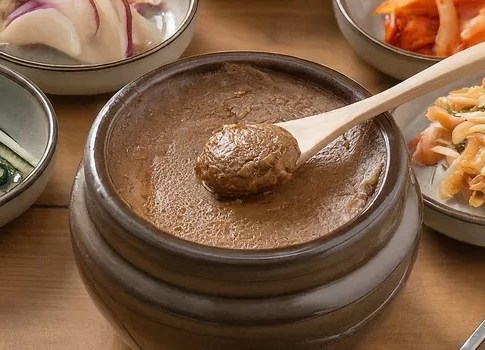Doenjang is a cornerstone of Korean cuisine, known for its deep, savory flavor. This fermented soybean paste is made from soybeans and salt and is used in various dishes such as soups, stews, and sauces. Making doenjang at home is a traditional process that requires patience and careful attention to detail. Here’s how to make traditional doenjang from scratch.
Our Traditional Doenjang Recipe continues after this advertisement:
Traditional Doenjang Recipe (Korean Fermented Soybean Paste)
Ingredients:
- 2 kg soybeans
- 4 liters water (for boiling)
- 1 kg coarse sea salt
- 10 liters water (for brine)
- 3-4 pieces dried kelp (optional)
- 1 cup dried chili peppers (optional)
Doenjang Instructions:
Prepare the Soybeans:
Rinse the soybeans thoroughly under cold water. Soak them in plenty of water overnight or for at least 12 hours.
Cook the Soybeans:
Drain the soaked soybeans and place them in a large pot with 4 liters of water. Bring to a boil over high heat, then reduce the heat to medium and simmer for 3-4 hours until the beans are soft and fully cooked. Skim off any foam that forms on the surface.
Once cooked, drain the beans and let them cool slightly.
Mash the Soybeans:
Using a food processor, blender, or traditional stone mortar, mash the beans into a coarse paste. If using a food processor, do this in batches to ensure an even consistency.
Form and Dry the Meju Blocks:
Shape the mashed soybean paste into rectangular blocks (meju) about the size of a brick.
Place the meju blocks on a clean, breathable surface, like a wooden board, and let them air dry in a well-ventilated area for about a week. Turn the blocks occasionally to ensure even drying. The blocks should become firm and start to develop cracks.
Ferment the Meju Blocks:
Once the meju blocks are dry, tie them together with string and hang them in a warm, dry place for several weeks to ferment. The ideal temperature for fermentation is around 25-30°C (77-86°F). During this time, the blocks will develop mold, which is crucial for the fermentation process.
Prepare the Brine:
After the fermentation period, prepare a brine by dissolving 1 kg of coarse sea salt in 10 liters of water. Stir well until the salt is fully dissolved.
Ferment the Doenjang:
Place the fermented meju blocks into a large earthenware jar (onggi) or a large glass jar. Add the dried kelp and dried chili peppers (if using) to the jar.
Pour the prepared brine over the meju blocks, ensuring they are fully submerged. Cover the jar with a breathable cloth or lid and let it ferment in a cool, dark place for 2-3 months.
Final Processing:
After 2-3 months, the liquid in the jar will have separated into a clear, brownish liquid (soy sauce) and the solid soybean paste (doenjang).
Carefully ladle out the liquid and store it separately as soy sauce. Transfer the solid doenjang to a separate clean jar or container.
Mature the Doenjang:
Let the doenjang mature for another few months in a cool, dark place. The longer it ferments, the deeper and more complex the flavor will become.
Tips to prepare Doenjang:
- The fermentation process may vary based on the climate and conditions. Ensure that the fermentation area is clean and free from contaminants.
- Always use clean utensils when handling the fermented paste to avoid contamination.
- You can adjust the saltiness of the brine to your preference, but ensure there is enough salt to prevent spoilage.
Using Doenjang:
Once matured, doenjang can be used in a variety of Korean dishes such as doenjang jjigae (soybean paste stew), sauces, marinades, and more. Enjoy the rich, savory flavor of your homemade doenjang in your favorite Korean recipes.

Related stories
Chinese Restaurant Syndrome – is MSG safe?
Recipe for popular Korean dish Gimbap
Australia’s best tasting heirloom tomatoes
Delicious and Easy Air Fryer Recipes
A True History of Vegemite, manna from Heaven
Global Food Production Dilemma: Grow & Buy Local
Lunar Agriculture: Plants to be Grown on the Moon
Should You Buy at Farmer’s Markets or Supermarkets?
Are Salt and Pepper Shakers collectible? What to look for
What to look for when collecting Egg Cups




